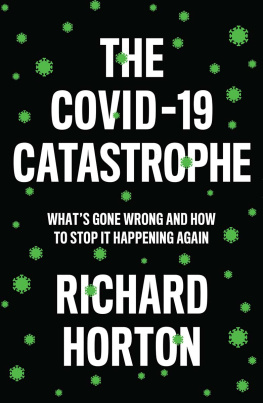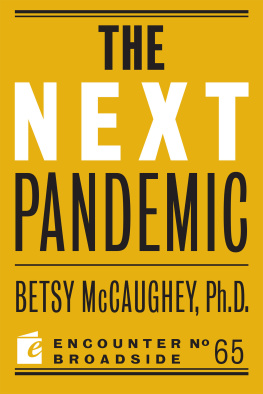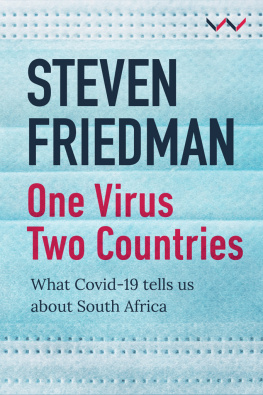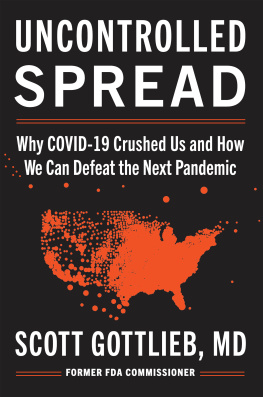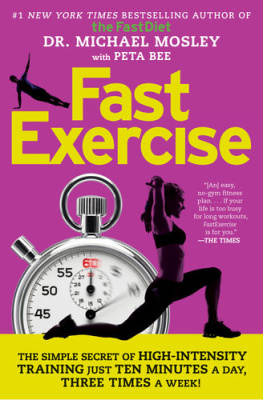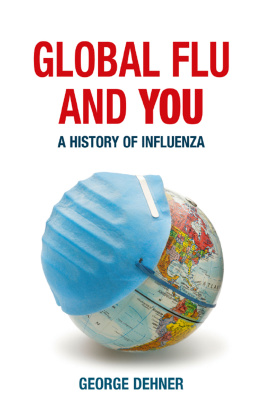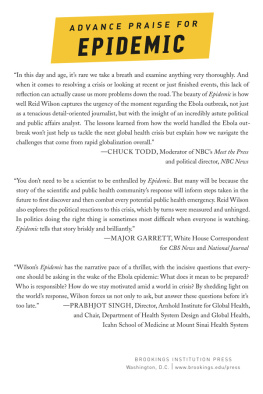
Dedication
For those whose lives were lost to COVID-19
The COVID-19 Catastrophe
Whats Gone Wrong and How to Stop it Happening Again
Richard Horton
polity
Copyright Richard Horton 2020
The right of Richard Horton to be identified as Author of this Work has been asserted in accordance with the UK Copyright, Designs and Patents Act 1988.
First published in 2020 by Polity Press
Polity Press
65 Bridge Street
Cambridge CB2 1UR, UK
Polity Press
101 Station Landing
Suite 300
Medford, MA 02155, USA
All rights reserved. Except for the quotation of short passages for the purpose of criticism and review, no part of this publication may be reproduced, stored in a retrieval system or transmitted, in any form or by any means, electronic, mechanical, photocopying, recording or otherwise, without the prior permission of the publisher.
ISBN-13: 978-1-5095-4647-3
A catalogue record for this book is available from the British Library.
The publisher has used its best endeavours to ensure that the URLs for external websites referred to in this book are correct and active at the time of going to press. However, the publisher has no responsibility for the websites and can make no guarantee that a site will remain live or that the content is or will remain appropriate.
Every effort has been made to trace all copyright holders, but if any have been overlooked the publisher will be pleased to include any necessary credits in any subsequent reprint or edition.
For further information on Polity, visit our website: politybooks.com
Fear can be considered the basis for all human civilization.
Lars Svendsen, The Philosophy of Fear (2008)
Preface
COVID-19 is a pandemic of paradoxes.
Most of those who became infected with this new coronavirus suffered only mild disease, perhaps not easily shaken off, yet shaken off nevertheless. But a substantial number perhaps as many as one in five developed a much more severe illness, often requiring intensive care and mechanical ventilation. For far too many, COVID-19 meant that death was their destiny.
Being older and living with chronic disease were important risks for worse outcomes. Yet a significant proportion of those who endured severe illness were also young and previously fit and well.
The scientific community made an astonishing contribution to producing the new knowledge needed to guide a response to COVID-19. But many questions about the virus and the disease it causes remain unanswered, leaving important gaps in our understanding of the pandemic that make its control exceptionally difficult.
The World Health Organization (WHO) acted with unprecedented velocity to declare a Public Health Emergency of International Concern (PHEIC). But the worlds only global health agency also struggled under intolerable political pressures to retain its credibility.
Countries pledged their support to international cooperation to defeat the pandemic. Yet those same countries were embarrassingly slow to match words with deeds, and too often they resorted to rivalry and blame.
This was a pandemic that was described and reported in terms of statistics numbers of infections, numbers of patients in critical care and numbers of deaths. Lives were transformed into mathematical summaries. Graphs of the epidemic were drawn. And countries were compared for their rates of mortality.
But those who died must not be summarised. They must not become lines on squared paper. They must not become mere rates used to argue differences between nations. Every death counts. A person who died in Wuhan is as important as one who died in New York. Our way of describing the impact of the pandemic erased the biographies of the dead. The science and politics of COVID-19 became exercises in radical dehumanisation.
At press conference after press conference, government ministers and their medical and scientific advisors described the deaths of their neighbours as unfortunate. But these were not unfortunate deaths. They were not unlucky, inappropriate or even regrettable. Every death was evidence of systematic government misconduct reckless acts of omission that constituted breaches in the duties of public office.
I edit a medical journal, The Lancet, which found itself a conduit between medical scientists desperately trying to understand COVID-19 and politicians and policymakers charged with responding to the pandemic. As we read and published the work of these remarkable frontline workers, I was struck by the gap between the accumulating evidence of scientists and the practice of governments. As this space grew larger, I became angry. Missed opportunities and appalling misjudgements were leading to the avoidable deaths of tens of thousands of citizens. There had to be a reckoning.
This book is their story.
Acknowledgements
I wrote this short book under lockdown in London. I owe a debt of thanks to many people. To Ingrid Wolfe, who welcomed me home. To Isobel and Aleem. To Laura, live long. To my colleagues at The Lancet who worked tirelessly to ensure that the most reliable research on COVID-19 was peer reviewed and published rapidly to support those responding on the frontlines of this pandemic. To the scientists in China, Hong Kong, Italy, the UK and elsewhere who took time under immense pressure and difficulty to describe their extraordinary experiences. To John Thompson, who took a chance. To Emma Longstaff, Helen Davies, Lucas Jones, Neil de Cort and Caroline Richmond from Polity, who helped to make the message real. And to three anonymous reviewers, whose comments and suggestions helped to sharpen the substance of my argument. As we have all learned to say: stay safe, stay strong.
From Wuhan to the World
While the human race battles itself, fighting over ever more crowded turf and scarcer resources, the advantage moves to the microbes court. They are our predators and they will be victorious if we, Homo sapiens, do not learn how to live in a rational global village that affords the microbes few opportunities.
Its either that or we brace ourselves for the coming plague.
Laurie Garrett, The Coming Plague (1994)
Something happened. The precise details still remain uncertain and may never be fully uncovered. But here is what one can reasonably be sure of so far.
On 30 December 2019, samples were taken from the lungs of a patient with a mysterious pneumonia. He had been admitted to Wuhan Jin Yin-tan Hospital in Wuhan, Hubei Province, China. A test called real-time reverse transcriptase polymerase chain reaction (RT-PCR) confirmed the presence of a new type of coronavirus.
Coronaviruses are common in animals, such as bats, cats and camels. There are hundreds of different types of coronavirus. Six had been known to infect human beings spillover infections into humans from their animal hosts. They are responsible for around 10 to 15 per cent of cases of the common cold.
Four human coronaviruses cause only mild to moderate symptoms NL63 (identified in the Netherlands in 2004), HKU1 (discovered in Hong Kong in 2005) and OC43 and 229E (both major causes of the common cold). But two coronaviruses pose much more serious threats to human health Severe Acute Respiratory Syndrome coronavirus (SARS-CoV-1) and Middle-East Respiratory Syndrome coronavirus (MERS-CoV). Could the virus discovered in Wuhan be a seventh and also more dangerous type of coronavirus?
The genetic code of the novel virus was quickly sequenced. Comparisons with existing viral genomes showed that it was closely related to a bat SARS-like strain. Those four letters S-A-R-S struck fear and not a little panic into Chinese health officials when the news arrived in Beijing. An outbreak of SARS in 20023 had infected 8,096 people and caused 774 deaths across 37 countries (a disturbingly high 10 per cent mortality rate). The political mishandling of that epidemic had brought widespread international criticism of Chinas leaders. A repeat of that national humiliation could not be allowed.
Next page
